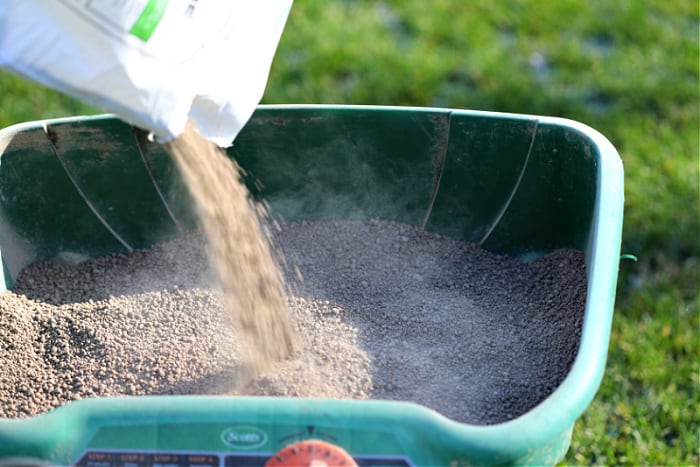What Is Lime?
Lime that gets applied to your lawn is made up of pelleted, or powdered limestone rock. Pelleted limestone has become preferred over powdered form, mostly because it’s easier to apply. Limestone naturally contains calcium carbonate and magnesium carbonate. These compounds help to amend soil, and neutralize a lawn that is too acidic.
Benefits of Lime for Your Lawn
Most lawns grow best with a soil pH between 6 and 7. If your lawn has a pH below 6 then your lawn is too acidic. An acidic lawn can’t effectively break down nutrients that get applied to your lawn when you fertilize. Adding lime to your lawn increases the pH (making it more alkaline), therefore correcting the low pH problem.
How to Tell If Your Lawn Needs Lime
The best thing you can do to get an accurate reading of your lawns pH is to use a simple soil test kit. The Yard Mastery Soil Test Kit is my favorite soil test kit on the market. You’ll get everything you need mailed to you so all you have to do is include a small sample of your lawns soil. Drop the sample in the mail and in a short amount of time you’ll get an accurate reading of your soils pH as well as nutrient levels in your lawn.
There’s no real way to tell visually if your lawns pH is off. If anything, you can suspect that the pH is the problem if you fertilize and you’re not seeing results. But still, the only real way to know is through a test. You may even have the opposite problem and your pH is too high. In this case you’d need to lower your pH.
When Should You Lime Your Lawn?
Fall and spring are the best times to lime your lawn. With the cooler weather and less intense sun you don’t have to worry about lime burning your lawn.
If your lawn is very acidic then 2 applications of lime might be needed. If this is the case then apply once in spring, and again in fall. Avoid the heat of the summer since lime can burn your lawn.
Follow up after your lime application with a soil test to see if the pH problem is getting better. Keep in mind, it takes time. If you do a lime application in the fall, don’t test the soil until next spring. For spring applications don’t bother testing until the fall. Doing a test too close to an application can result in an inaccurate reading.
How Much Lime to Add to Your Lawn
How much lime to add to your lawn depends on 2 factors. Your soils pH, and also the soil type (sand, loam, clay).

*Tip- If you fall into a category of needing more than 100 lbs. per 1000 s/f to solve your pH problem it’s recommended you solve the problem over multiple years. Sticking to 2 applications a year is best with a maximum amount of 50 lbs. per 1000 s/f per application. This makes a 100 lbs. per 1000 s/f a year maximum.
How to Apply Lime to Lawn
1. Take A Soil Test- Take a soil test to determine your lawn’s pH. Also, observe if your soil is sandy, loamy, or full of clay. You can take the mud shake test to if you can’t tell just by looking.
2. Figure Out Application Rate- To figure out how much Lime you need simply measure the square footage of your lawn, and then use the chart above to figure out how much lime you should apply per 1000 s/f.
3. Purchase Lime- Purchase a quality pelletized lime such as Soil Doctor Lawn Lime. This can be purchased at big box stores, garden centers, or online.
4. Set Spreader and Apply- A reliable broadcast spreader is much better than a drop spreader. Most granular lime products will have recommended spreader settings on the bag so you should simply be able to look up the spreader you have and what setting to use. If this information isn’t on the bag than you’ll have to do some experimenting to figure out what setting to use.
The best thing you can do is find a small section of your lawn, say 1000 s/f for example. Fill your spreader with your lbs. per 1000 s/f number. In this example lets say you have a pH of 6 and loamy soil. Looking at the chart above that means you have to apply 30 lbs. of lime over that 1000 s/f. Pour 30 lbs. of lime into your spreader and set the spreader to a low setting at first and do a pass. Take note if a lot of lime came out or a little. Adjust the spreader accordingly. It may take some tweaking back and forth but eventually you’ll get a good feel of what setting to use to evenly cover that 1000 s/f with lime. There’s a great write up on understanding application rates here: How to Fertilize Your Lawn
5. Water- If you have an irrigation system than irrigate after applying lime. If you can’t water afterwards it’s really not a problem as long as you don’t apply during a stretch of hot, dry weather. This could stress your lawn.
FAQ
– Can you apply lime, fertilizer, and seed at the same time?
The short answer is yes. Just make sure you avoid mid summer months or if your lawn is showing signs of stress.
-Do pine needles make the soil more acidic?
This is one of the great lawn myths. While pine needles are acidic, by the time they get broken down and enter your lawns soil they are neutralized by microbes in the lawn. Pine trees prefer acidic soil but they don’t create it. If you see bare lawn spots underneath your pine trees it is most likely due to their shallow root systems interfering with your lawns roots.
– Is Lime Fertilizer?
No, lime is not a substitute for fertilizer. You’ll want to adopt a fertilizer program that supplies your lawn with the 3 main macro nutrients that grass needs (Nitrogen, Phosphorus, and Potassium).
– How long does it take for lime to change pH?
Lime takes about 3 months until you start to see an increase in your soils pH. If you’re looking to make a significant increase in the pH of your soil it will be a several year process with several applications of lime.
– Does lime need to be watered in?
Yes, but not right away. It is best to water in lime as soon as you can but it shouldn’t harm your lawn if you are waiting for the next rain to come. Just avoid applying lime in mid summer or on hot days since it can burn your lawn.
Check Out These Posts Next
Top Dressing Lawn: Benefits and Advice
Kill Weeds Without Killing Grass
Follow Me
Join my free email list!



I really need to aerate and oversees my lawn, but missed the fall window. Can I do this in early spring, say mid to late March? I live on Cape Cod.
Yes you can, it’s just not as good as early fall. Just realize you’re going to get some weeds that grow as well. In the fall when the broadleaf weeds die back your lawn will dominate. The following spring you will want to block those weeds using a pre-emergent. My preferred method would be to fertilize and block weeds in spring, and continue to feed the lawn until its fall. Then I would core aerate and overseed. But to answer your question, yes it can be done, especially if you have an irrigation system and can keep the new grass irrigated during the hot summer months.
Hello Mark, Thank you for all of your valuable information. It seems that moss is becoming a more prevalent lawn problem, not sure why but a article covering moss control would be great! Also, water shortages, bans on sprinkler systems has made watering a lawn a real challenge. Ways and methods to compensate for water shortages would also be extremely helpful. I see that Scotts offers a grass seed that compensates for lack of water but I feel that this is more of a marketing hype. As always, thank you for your help! I live south of Boston.